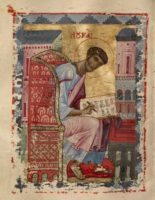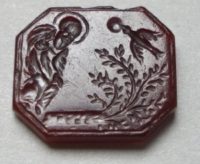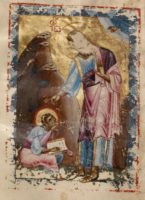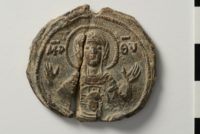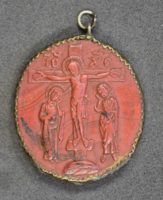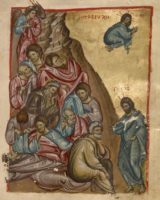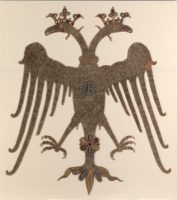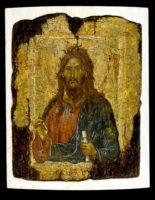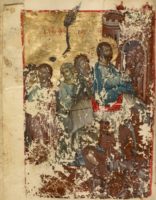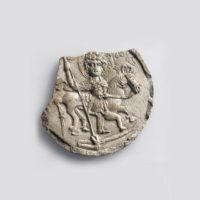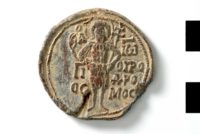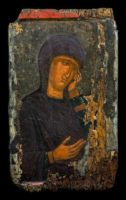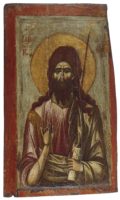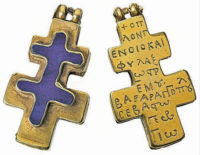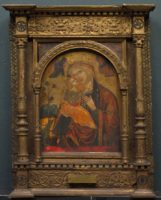The Descent into Limbo, Period: Late Byzantine, circa: 13th century. Dimensions: Leaf: 20.6 × 14.9 cm (8 1/8 × 5 7/8 in.) Place: Nicaea, Modern Turkey (Place created).
Museum Description: “After his Crucifixion and before his Resurrection, Christ freed worthy Bible figures from limbo (an event known as the Anastasis in Greek). Here Christ pulls Adam by the wrist out of the tomb and toward the Kingdom of Heaven, while Abel, Eve, John the Baptist, King Solomon, and King David await their salvation. The two kings are dressed in the jeweled crowns and embroidered cloaks of Byzantine emperors.”
The collection of the J. Paul Getty Museum comprises Greek, Roman, and Etruscan art from the Neolithic to Late Antiquity; European art—including illuminated manuscripts, paintings, drawings, sculpture, and decorative arts—from the Middle Ages to the early twentieth century; and international photography from its inception to the present day.
Saint Luke, Manuscript, Period: Late Byzantine circa: early 13th century. Place: Nicomedia (Modern Izmit, Anatolia, Turkey) Materials: Tempera colors and gold leaf on parchment. Dimensions: Leaf: 20.6 × 14.9 cm (8 1/8 × 5 7/8 in.) Museum Description: “Before the Gospel of Saint Luke, the illuminator placed a portrait of the evangelist. Seated in an elaborate throne with his book open on his knees, Luke writes his Gospel, his account of Jesus’ life and teachings. The tradition of including author portraits in manuscripts began in antiquity; by the thirteenth century, the inclusion of portraits of the evangelists in Gospel books had become quite common. ”
The J. Paul Getty Museum at the Getty Center in Los Angeles houses European paintings, drawings, sculpture, illuminated manuscripts, decorative arts, and photography from its beginnings to the present, gathered internationally.
Octagonal intaglio, Period: Late Byzantine; circa: 14thc. Made in: Constantinople. Dimensions: Height: 1.7 centimetre. Material: sard. British Museum is closed 24, 25 and 26 December and 1 January, but is open every other day of the year. Fast facts about the British Museum: Founded: 1753, Collection size: 8 million objects, Oldest object in the collection: Stone chopping tool (nearly 2 million years old).
Saint John the Evangelist Dictating, Manuscript, Period: Late Byzantine; circa: 1200 to 1225. Place: Nicomedia (Modern Izmit, Turkey) Materials: Tempera colors and gold leaf on parchment. Dimensions: Leaf: 20.6 × 14.9 cm (8 1/8 × 5 7/8 in.) The J. Paul Getty Museum at the Getty Center in Los Angeles houses European paintings, drawings, sculpture, illuminated manuscripts, decorative arts, and photography from its beginnings to the present, gathered internationally.
Constantine Xeros, Sebastos. Period: Late Byzantine, 12th.c. second half. Translation: May you, all-holy Virgin, be the keeper and seal of the correspondence of the sebastos Constantine Xeros. The museum is open to the public Tuesday through Sunday, 11:30 a.m.–5:30 p.m., except for federal holidays.
Glass Cameo, Period: Late Byzantine; circa: 13th century A.D. Brick-red, opaque; on the front, the Crucifixion with, the Virgin at left, St John at right. Set in a metal frame. Diameter: 51 millimetres. British Museum is closed 24, 25 and 26 December and 1 January, but is open every other day of the year. Fast facts about the British Museum: Founded: 1753, Collection size: 8 million objects, Oldest object in the collection: Stone chopping tool (nearly 2 million years old).
The Agony in the Garden, Manuscript, Period: Late Byzantine; circa: 1200 to 1299 A.D. Place: Nicaea. (Modern Turkey) Material: Tempera colors and gold leaf on parchment bound between wood boards covered with light brown velvet. Dimensions: Leaf: 20.6 × 14.9 cm (8 1/8 × 5 7/8 in.)
Museum Description: “Placed within the Gospel of Matthew, the full-page miniature of the Agony in the Garden represents one of the more powerfully emotional moments in Jesus’ Passion. After the Passover meal, Jesus and his apostles retire to the Garden of Gethsemane, where Jesus foretells Saint Peter’s betrayal. Jesus then asks his closest disciples to stay awake with him, but later, while he prays, the apostles fall asleep.
The artist represents Jesus twice in the miniature: once confronting Peter at the bottom of the image and then praying above. Jesus’ feelings of isolation and abandonment as he prays are expressed visually by his physical separation not only from the apostles but also from the angel shown behind him. Against the hilly landscape, the apostles huddle together in their sleep, their bodies forming a mound almost as large as the mountain itself. The crisp folds of their garments are made of embedded geometric forms that echo the shape of the rocks at the top of the mountain.“
The J. Paul Getty Museum at the Getty Center in Los Angeles houses European paintings, drawings, sculpture, illuminated manuscripts, decorative arts, and photography from its beginnings to the present, gathered internationally.
The Last Supper, Period: Late Byzantine; circa: 13th century, Place: Nicaea, Modern Turkey. (created) Dimensions: Leaf: 20.6 × 14.9 cm (8 1/8 × 5 7/8 in.).
The J. Paul Getty Museum at the Getty Center in Los Angeles houses European paintings, drawings, sculpture, illuminated manuscripts, decorative arts, and photography from its beginnings to the present, gathered internationally.
Cameo; opaque red; Period: Late Byzantine circa: 13 thc. Materials: glass. Made in: Venice. The Crucifixion with St John and St Mary and inscription, in relief. British Museum is closed 24, 25 and 26 December and 1 January, but is open every other day of the year. Fast facts about the British Museum: Founded: 1753, Collection size: 8 million objects, Oldest object in the collection: Stone chopping tool (nearly 2 million years old).
Altar Cloth or Podea. Period: Late Byzantine, circa: late 14th century. Made in: probably Greece or Constantinople. Materials: Silk, embroidery. Dimensions: 58 1/2 x 51 1/8 in. (148.6 x 129.9 cm).
Museum Description: “The double-headed eagle became the primary symbol of the state during the late Byzantine centuries and was also adopted for liturgical use. This huge eagle was probably used as an altar cloth or as a podea, a skirt hung beneath an icon. The inscription, which connects the owner with distinguished imperial dynasties, exaggerated the claims of a pretender to the patriarchal throne.”
On view at The Met Fifth Avenue in Gallery 303. The Metropolitan Museum of Art (New York) is one of the world’s largest and finest art museums. Its collection includes more than two million works of art spanning five thousand years of world culture, from prehistory to the present and from every part of the globe. Public Hours: 10:30 a.m.–5:30 p.m. Open seven days a week.
Icon with St John the Baptist, Icon painted in egg tempera with gold leaf on a wood panel surfaced with gesso and linen; the panel has a raised border. Period: Late Byzantine, 1300 (circa), Made in: Constantinople (Modern Istanbul, Turkey). Dimensions: Height: 251 millimetresWidth: 202 millimetres. British Museum is closed 24, 25 and 26 December and 1 January, but is open every other day of the year. Fast facts about the British Museum: Founded: 1753, Collection size: 8 million objects, Oldest object in the collection: Stone chopping tool (nearly 2 million years old).
The Entry into Jerusalem, Period: Late Byzantince circa: 13 th century. Place (created): Nicaea (Modern Iznik, Turkey, Anatolia). Dimensions: Leaf: 20.6 × 14.9 cm (8 1/8 × 5 7/8 in.). Materials: Tempera colors and gold leaf on parchment. The J. Paul Getty Museum at the Getty Center in Los Angeles houses European paintings, drawings, sculpture, illuminated manuscripts, decorative arts, and photography from its beginnings to the present, gathered internationally.
Icon of St George, Period: Late Byzantine, circa: 13th century. Material: soapstone. Dimensions: 6,6 x 7,4 cm. The collection of the State Hermitage includes over 3 million works of art and world culture artefacts. It contains paintings, graphic works, sculptures, works of applied art, archaeological artefacts and numismatic objects. The Hermitage is considered to have been founded in 1764, when Empress Catherine the Great acquired an impressive collection of works from the Berlin merchant Johann Ernst Gotzkowsky. The museum celebrates the anniversary of its founding each year on 7 December, St. Catherine’s Day. Opening Hours: Tuesday, Thursday, Saturday, Sunday: 10.30-18.00 Wednesday, Friday: 10.30-21.00 Closed: Monday.
Seal, John Tarchaneiotes, Period: Late Byzantine, 13 th. century. (second half). St. John the Baptist standing, holding a staff cross over his left shoulder. The museum is open to the public Tuesday through Sunday, 11:30 a.m.–5:30 p.m., except for federal holidays.
Icon of Depicting Virgin Mary Thornousa, which was probably part of a wider composition depicting Extreme Humiliation or Crucifixion. Period: Late Byzantine; circa: The fourth quarter of the 14th century. The shape of the Virgin Mary, with the scattered hair and the deformed by pain characteristics, refers to the expressive, anti-classical flow of Byzantine painting.
Icon, St John the Baptist. Period: Late Byzantine; circa: Early 14th century. Place: Byzantium, Athos. Technique: tempera on panel lined with canvas. Dimensions: 66x39x2,2 cm. The collection of the State Hermitage includes over 3 million works of art and world culture artefacts. It contains paintings, graphic works, sculptures, works of applied art, archaeological artefacts and numismatic objects. The Hermitage is considered to have been founded in 1764, when Empress Catherine the Great acquired an impressive collection of works from the Berlin merchant Johann Ernst Gotzkowsky. The museum celebrates the anniversary of its founding each year on 7 December, St. Catherine’s Day. Opening Hours: Tuesday, Thursday, Saturday, Sunday: 10.30-18.00 Wednesday, Friday: 10.30-21.00 Closed: Monday.
Byzantine Pectoral Cross (front and back), Period: Late Byzantine circa: 1200–1400 A.D. , Benaki Museum, Athens. Museum Description: “Gold pectoral in the form of a Resurrection cross with double horizontal arms set with lapis lazuli. The owner’s name, Georgios Varagkopoulos, is inscribed on the back together with his title Sevastos (Augustus), which reflects his high social standing and explains the luxurious quality of the materials and the fine workmanship. “
The Benaki Museum of Greek Culture is housed in one of the most beautiful neoclassical-style buildings in Athens, near the National Garden and the Hellenic Parliament. It was converted into a museum in order to shelter the collections of Antonis Benakis and was donated to the Greek nation by himself and his three sisters, Alexandra, Penelope and Argine. Following its most recent refurbishment (1989–2000), the building houses a unique exhibition on Greek culture arranged diachronically from prehistory to the 20th century.
Relief plaque icon, depicting the Crucifixion with full-length figures of the Virgin on the left and St John on the right, Late Byzantine (13 thc). Materials: Steatite – Gold.
Virgin and Child, Medium: tempera and gold on wood, Type of art work: Painting, Period: Late Byzantine, circa: 1400s. Framed: 63.5 x 50.8 x 10.1 cm (25 x 20 x 4 in.); Unframed: 38.5 x 29.3 cm (15 1/8 x 11 1/2 in.). The Cleveland Art Museum Hours: Tuesdays, Thursdays, Saturdays, Sundays 10:00 a.m.–5:00 p.m. Wednesdays, Fridays 10:00 a.m.–9:00 p.m. Closed Mondays.
Christ Pantocrator with Donators, Period: Late Byzantine, circa: Circa 1363. Technique: tempera on panel. Dimensions: 106 x 79 x 2,8 cm. The collection of the State Hermitage includes over 3 million works of art and world culture artefacts. It contains paintings, graphic works, sculptures, works of applied art, archaeological artefacts and numismatic objects. The Hermitage is considered to have been founded in 1764, when Empress Catherine the Great acquired an impressive collection of works from the Berlin merchant Johann Ernst Gotzkowsky. The museum celebrates the anniversary of its founding each year on 7 December, St. Catherine’s Day. Opening Hours: Tuesday, Thursday, Saturday, Sunday: 10.30-18.00 Wednesday, Friday: 10.30-21.00 Closed: Monday.



